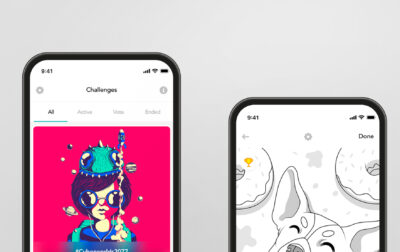Top frameworks for mobile development: Finding the ultimate match for your business
Intro
Smartphones are now a natural part of our everyday life, from waking up to watching shows. Frameworks, the unseen architects at the core of these experiences, power up these functions to run smoothly. Thus, to make a definitive choice of the best mobile app development framework is more than a technical decision; it is a strategic move for businesses aiming to scale efficiently and deliver exceptional user journeys. For companies, the right framework can mean faster development, smoother scaling, and a more engaging app experience for users across platforms, which results in user retention.
In this blog piece, our team at Touchlane delves into the varieties of frameworks, analyzes their pros and cons, and offers professional advice on how to make a well-informed choice based on our years of expertise in designing top-performing mobile apps. If you are new to mobile development frameworks, consider this your insider’s guide to navigating the landscape with confidence.
What do we mean by a mobile app development framework?
Basically, a mobile app development framework is a mix of instruments, repositories, and optimal techniques that alleviates difficulties in producing mobile apps across a range of platforms. Frameworks present a structured setup and give developers the freedom to emphasize the app’s functionalities and user engagement without getting caught up in the complexities of the operating systems (OS).
Categories of frameworks for mobile development
In the mobile development domain, frameworks support software project teams in concentrating on their core priorities: making their products easy to use, packed with features, and ready for anything.
But picking the right one depends on grasping the diverse frameworks categories available out there. Let’s take a look at them.
Native frameworks
Created with only one OS in mind, native frameworks let engineers utilize programming languages that fit each platform perfectly. These comprise Objective-C or Swift for iOS, as well as Java or Kotlin for Android. Commonly known for being fast, native apps can take full advantage of what a user’s phone or tablet can do. For businesses, this means higher customer satisfaction.
Pros
- Maximum efficiency and rapid response
- Outstanding user journey
- Connection to all integrated sensors and device features.
Cons
- Additional expenses from parallel development for two OS
- Prolonged development cycle.
Cross-platform frameworks
Empowered by cross-platform frameworks, engineers have the capability to craft applications that run on various systems with just one codebase. This concludes in less time spent on coding, allowing them to deliver their app on iOS, Android, and the web with minimal changes. Preferred languages for cross-platform development comprise JavaScript, Dart, and C#.
At Touchlane, we recommend cross-platform platforms for companies looking to bring an MVP to life as soon as possible and save money throughout the development process.
Pros
- Decreased expenses and development timeline
- Unified codebase applicable across platforms, resulting in easier deployment and maintenance
- Thriving community and plug-in infrastructure.
Cons
- Insufficient access to native functionalities
- Likely performance issues in comparison with native applications.

Hybrid frameworks
Working with hybrid frameworks blends web (HTML, CSS) and mobile (JavaScript) technologies together. Hybrid applications function inside a native container, but they can use the features of a phone or tablet thanks to plugins like Apache Cordova. Overall, hybrid frameworks are perfect for companies aiming to rapidly roll out apps on both major OS while minimizing the high costs of native development.
Pros
- Affordable and more rapid development
- Can run on any platform with only minor code tweaks
Cons
- Weaker performance as opposed to native apps
- User journey could feel somewhat less “native”.
Interested in mobile app development? Connect with seasoned mobile engineers at Touchlane.
What are the best mobile application development frameworks in 2024?
In 2024, the ecosystem of mobile app development is defined by several key frameworks. At Touchlane, we suggest taking a deeper look into the five following ones.
React Native
![]()
Type
- Cross-platform
Key features
React Native is a fantastic tool for building apps that work just as well on iOS as they do on Android. It permits a one-time code write-up for use on both platforms, which is a huge time-saver. One of its standout features is hot reloading, which lets programmers view updates immediately without having to rebuild the entire app. And with a wide range of third-party plugins and libraries at disposal, React Native makes it easy to add all kinds of features to your app without a lot of extra coding.
Why choosing it
For companies looking to maximize productivity, using React Native is a calculated move. A fluid user journey is guaranteed by its capacity to supply near-native functionality employing native elements, which is critical for gaining momentum in cutthroat markets. The framework has a thriving community and Facebook backing, which guarantees ongoing enhancement and an abundance of tools for developers.
Popular apps
Facebook, Instagram, UberEats
Flutter 
Type
- Cross-platform
Key features
The framework incorporates a robust array of configurable widgets and seamless animations, allowing developers for building high-quality visual interfaces effortlessly. Being a cross-platform framework, Flutter stands out for its capability to develop a unified codebase that can be used on all platforms, including, alongside mobile, web and desktop apps.
Why choosing it
Companies, especially startups, may find Flutter particularly appealing due to its rapid prototyping capabilities. Quick iterations are made possible due to a rich library of widgets. Furthermore, Flutter compiles to native ARM code, thus, providing high performance across devices. With Google’s backing, the framework is well-positioned for future growth.
Popular apps
Google Ads, BMW My App, Alibaba’s Xianyu
Swift 
Type
- Native
Key features
Swift is a modern language that is easy to learn and read, even if someone is new to programming. It is optimized for speed and efficiency, and it has safety features such as strong typing and error handling to help developers reduce common coding mistakes.
Why choosing it
If your team is building an app for iPhones and/or iPads, Swift is the way to go. It is the fastest and most powerful language for Apple’s ecosystem, and it is always up-to-date with the latest features. Plus, it can work with older apps written in Objective-C, so you can update your app gradually.
Popular apps
Uber, Slack, Lyft
Kotlin 
Type
- Native
Key features
Kotlin is the go-to language for Android apps. It works impeccably with Java, so it is easy to switch from old Java apps. Kotlin’s code is shorter and easier to read, helping developers to complete tasks more swiftly and make their apps easier to maintain. Plus, Kotlin helps prevent crashes caused by null pointers, making apps more reliable.
Why choosing it
Kotlin is a strategic choice for businesses that build Android apps. Google backs it as the favored language, and there is a thriving developer community that shares lots of resources and tools. Kotlin’s features, like extension functions and smart casts, make coding more efficient and straightforward.
Popular apps
Pinterest, Evernote, Coursera

How to decide on the best framework for mobile app development: Points and contemplations
So, what is the best mobile app framework? Well, ultimately, this decision is yours to take, but in this section, we offer some professional advice based on the information above and Touchlane’s own experience.
First of all, ask yourself three vital questions:
- Do you want your app to include a set of fancy, more complex tools or do you want to start with a simpler app?
- What is the expertise of your development team? Do you have necessary resources to support your app post-launch?
- Does the size of your company align with the resource demands of the mobile development framework you are considering? What is your ultimate budget and the ROI you expect from it?
Based on your answers, proceed to look into the most important factor in choosing your mobile app development framework.
Efficiency & speed
If you need your app to be high-performing and look appealing, then native frameworks are the preferred way to go. For simpler apps or MVPs, cross-platform might be enough.
Expenses
Since you generally need separate teams for iPhone and Android apps, going for native frameworks might lead to increased expenses. At the same time, cross-platform frameworks present a more affordable option, especially for startups or businesses testing out new ideas on a budget.
Timeline
If time is of the essence and you intend for your company’s app to function on both Android and iOS, going for cross-platform frameworks could be your best bet. They let you build prototypes and develop apps much quicker.
User journey
Native apps deliver a more organic and refined user journey, as they align with the design conventions of each interface. Likewise, cross-platform apps can be fairly aligned, but they still might miss some of the finer details like gestures and fluid animations.
Scalability & maintenance
Consider how your app will evolve. Supporting and expanding apps that are crafted with cross-platform frameworks at their core is more manageable, as there is just one code structure to revise. But even though native applications could be more challenging to maintain, they provide greater adaptability for complex functionalities.
Conclusion
Discovering the framework that handles app design processes is a key decision. It affects how swiftly your app performs, how good it feels to use, and how much it costs to produce. While native frameworks are recognized for top-notch operation and employment of the phone or tablet’s functionalities, opting for cross-platform frameworks is typically quicker to initiate and less expensive. Should you need a balance of time and investment, your ideal choice depends on what you want to achieve in the long run.
But the choice should not be a burden to bear alone. As a seasoned mobile app development company, Touchlane is here to help you assess the project specifications or hire senior-only mobile app developers to boost your initiatives. Reach out to us to get an estimate or have an experience-based opinion on the matter of frameworks.
RELATED SERVICES
CUSTOM SOFTWARE DEVELOPMENT
If you have an idea for a product along with put-together business requirements, and you want your time-to-market to be as short as possible without cutting any corners on quality, Touchlane can become your all-in-one technology partner, putting together a cross-functional team and carrying a project all the way to its successful launch into the digital reality.
If you have an idea for a product along with put-together business requirements, and you want your time-to-market to be as short as possible without cutting any corners on quality, Touchlane can become your all-in-one technology partner, putting together a cross-functional team and carrying a project all the way to its successful launch into the digital reality.
We Cover
- Design
- Development
- Testing
- Maintenance











